Wellington
Wellington (Māori: Te Whanganui-a-Tara [tɛ ˈfaŋanʉi a taɾa]) is the capital city of New Zealand. It is located at the south-western tip of the North Island, between Cook Strait and the Remutaka Range. Wellington is the major population centre of the southern North Island, and is the administrative centre of the Wellington Region, which also includes the Kapiti Coast and the Wairarapa. It is the world's southernmost capital of a sovereign state.[3] Wellington features a temperate maritime climate, and is the world's windiest city by average wind speed.[4]
Wellington Te Whanganui-a-Tara (Māori) | |
|---|---|
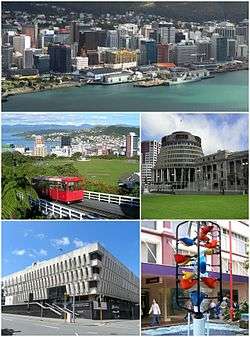 Clockwise from top: Waterfront along Wellington Harbour, Parliament Buildings, The Bucket Fountain, National Library, Wellington Cable Car | |
 Flag  Coat of arms | |
| Nickname(s): Windy Wellington, Wellywood | |
 Wellington Location in New Zealand & Pacific Ocean 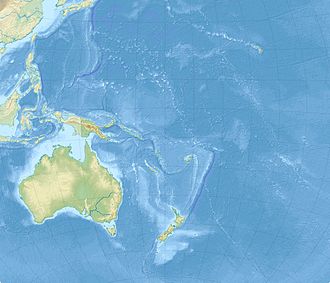 Wellington Wellington (Oceania) 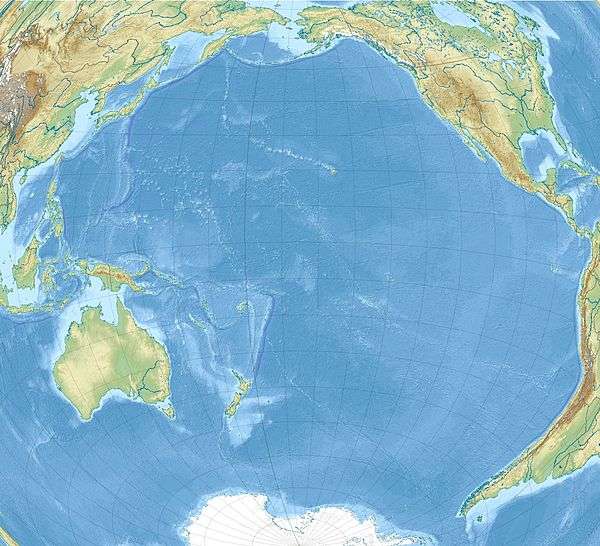 Wellington Wellington (Pacific Ocean) | |
| Coordinates: 41°17′20″S 174°46′38″E | |
| Country | |
| Region | Wellington |
| Territorial authorities | Wellington City Lower Hutt City Upper Hutt City Porirua City |
| Settled by Europeans | 1839 |
| Named for | A. Wellesley, 1st Duke of Wellington |
| Government | |
| • Mayor | Andy Foster |
| Area | |
| • Urban | 442 km2 (171 sq mi) |
| • Metro | 1,388 km2 (536 sq mi) |
| Highest elevation | 495 m (1,624 ft) |
| Lowest elevation | 0 m (0 ft) |
| Population (June 2019)[2] | |
| • Urban | 215,400 |
| • Urban density | 490/km2 (1,300/sq mi) |
| • Metro | 424,200 |
| • Metro density | 310/km2 (790/sq mi) |
| • Demonym | Wellingtonian |
| Time zone | UTC+12 (NZST) |
| • Summer (DST) | UTC+13 (NZDT) |
| Postcode(s) | 5010, 5011, 5012, 5013, 5014, 5016, 5018, 5019, 5022, 5024, 5026, 5028, 6011, 6012, 6021, 6022, 6023, 6035, 6037 |
| Area code(s) | 04 |
| Local iwi | Ngāti Toa Rangatira, Ngāti Raukawa, Te Āti Awa |
| Website | www.wellingtonnz.com |
The position of Wellington as capital of New Zealand is not defined in legislation, but established by convention.[5] Its metropolitan area comprises four local authorities: Wellington City, on the peninsula between Cook Strait and Wellington Harbour, contains the central business district; Porirua on Porirua Harbour to the north is notable for its large Māori and Pacific Island communities; Lower Hutt and Upper Hutt are largely suburban areas to the northeast, together known as the Hutt Valley. The Wellington urban area, which only includes urbanised areas within Wellington City, has a population of 215,400 residents as of June 2019.[2] The urban areas of the four local authorties have a combined population of 416,800 residents as of June 2019.[2]
As the nation's capital since 1865,[5] the New Zealand Government and Parliament, the Supreme Court, and most of the public service are based in the city. Architectural sights include the Old Government Buildings—one of the largest wooden buildings in the world—as well as the iconic Beehive, the executive wing of Parliament Buildings. Wellington is also home to several of the largest and oldest cultural institutions in the nation, such the National Archives, the National Library, the Museum of New Zealand Te Papa Tongarewa, and numerous theatres. It plays host to many artistic and cultural organisations, including the New Zealand Symphony Orchestra and Royal New Zealand Ballet. One of the world's most liveable cities, the 2016 Mercer Quality of Living Survey ranked Wellington 12th in the world, and was first in the world for both liveability and non-pollution by Deutsche Bank, from 2017–18.[6][7]
Wellington's economy is primarily service-based, with an emphasis on finance, business services, and government. It is the centre of New Zealand's film and special effects industries, and increasingly a hub for information technology and innovation,[8] with two public research universities. Wellington is one of New Zealand's chief seaports and serves both domestic and international shipping. The city is served by Wellington International Airport, the third busiest airport in the country. Wellington's transport network includes train and bus lines which reach as far as the Kapiti Coast and the Wairarapa, and ferries connect the city to the South Island.
Described by Lonely Planet in 2013 as "the coolest little capital in the world",[5][9] the world city[10][11] has grown from a bustling Māori settlement, to a remote colonial outpost, and from there to an Australasian capital experiencing a "remarkable creative resurgence".[12][13]
Toponymy
Wellington takes its name from Arthur Wellesley, the first Duke of Wellington and victor of the Battle of Waterloo (1815): his title comes from the town of Wellington in the English county of Somerset. It was named in November 1840 by the original settlers of the New Zealand Company on the suggestion of the directors of the same, in recognition of the Duke's strong support for the company's principles of colonisation and his "strenuous and successful defence against its enemies of the measure for colonising South Australia". One of the founders of the settlement, Edward Jerningham Wakefield, reported that the settlers "took up the views of the directors with great cordiality and the new name was at once adopted".[14]
In the Māori language, Wellington has three names. Te Whanganui-a-Tara refers to Wellington Harbour and means "the great harbour of Tara";[15] Pōneke is a transliteration of Port Nick, short for Port Nicholson (the city's central marae, the community supporting it and its kapa haka have the pseudo-tribal name of Ngāti Pōneke);[16] Te Upoko-o-te-Ika-a-Māui, meaning 'The Head of the Fish of Māui' (often shortened to Te Upoko-o-te-Ika), a traditional name for the southernmost part of the North Island, deriving from the legend of the fishing up of the island by the demi-god Māui. The legendary Maori explorer Kupe, a chief from Hawaiki (the homeland of Polynesian explorers, of unconfirmed geographical location, not to be confused with Hawaii), was said to have stayed in the harbour prior to 1000 CE.[17] Here, it is said he had a notable impact on the area, with local mythology stating he named the two islands in the harbour after his daughters, Matiu (Somes Island), and Mākaro (Ward Island).[18] However, the primary settlement of Wellington is said to have been executed by Tara, the son of Whatonga, a chief from the Mahia Peninsula, who told his son to travel south, to find more fertile lands to settle.[17]
In New Zealand Sign Language, the name is signed by raising the index, middle and ring fingers of one hand, palm forward, to form a "W", and shaking it slightly from side to side twice.[19]
The city's location close to the mouth of the narrow Cook Strait leaves it vulnerable to strong gales, leading to the nickname of "Windy Wellington".[20]
History
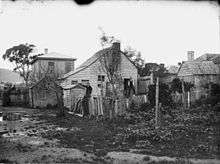
Māori settlement
Legends recount that Kupe discovered and explored the region in about the 10th century. Before European colonisation, the area in which the city of Wellington would eventually be founded was seasonally inhabited by indigenous Māori. The earliest date with hard evidence for human activity in New Zealand is about 1280.[21]
Wellington and its environs have been occupied by various Māori groups from the 12th century. The legendary Polynesian explorer Kupe, a chief from Hawaiki (the homeland of Polynesian explorers, of unconfirmed geographical location, not to be confused with Hawaii), was said to have stayed in the harbour from c. 925.[17][22] A later Māori explorer, Whatonga, named the harbour Te Whanganui-a-Tara after his son Tara.[23] Before the 1820s, most of the inhabitants of the Wellington region were Whatonga's descendants.[24]
At about 1820, the people living there were Ngāti Ira and other groups who traced their descent from the explorer Whātonga, including Rangitāne and Muaūpoko.[25] However, these groups were eventually forced out of Te Whanganui-a-Tara by a series of migrations other iwi (Māori tribes) from the north.[25] The migrating groups were Ngāti Toa, which came from Kāwhia, Ngāti Rangatahi, from near Taumarunui, and Te Atiawa, Ngāti Tama, Ngāti Mutunga, Taranaki and Ngāti Ruanui from Taranaki. Ngāti Mutunga later moved on to the Chatham Islands. The Waitangi Tribunal has found that at the time of the signing of the Treaty of Waitangi in 1840, Te Atiawa, Taranaki, Ngati Ruanui, Ngati Tama, and Ngati Toa held mana whenua interests in the area, through conquest and occupation.[25]
Early European settlement
Steps towards Pākehā (European) settlement in the area began in 1839, when Colonel William Wakefield arrived to purchase land for the New Zealand Company to sell to prospective British settlers.[25] Prior to this time, the Māori inhabitants had had contact with Pākehā whalers and traders.[26]
European settlement began with the arrival of an advance party of the New Zealand Company on the ship Tory on 20 September 1839, followed by 150 settlers on the Aurora on 22 January 1840. Thus the Wellington settlement preceded the signing of the Treaty of Waitangi (on 6 February 1840). The 1840 settlers constructed their first homes at Petone (which they called Britannia for a time) on the flat area at the mouth of the Hutt River. Within months that area proved swampy and flood-prone, and most of the newcomers transplanted their settlement, which had been planned without regard for a hilly terrain, across Wellington Harbour to Thorndon in the present-day site of Wellington city.
National capital
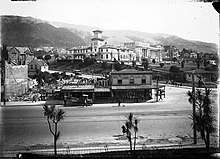
Wellington was declared a city in 1840, and was chosen to be the capital city of New Zealand in 1865.[5]
Wellington became the capital city in place of Auckland, which William Hobson had made the capital in 1841. The New Zealand Parliament had first met in Wellington on 7 July 1862, on a temporary basis; in November 1863, the Prime Minister of New Zealand, Alfred Domett, placed a resolution before Parliament in Auckland that "... it has become necessary that the seat of government ... should be transferred to some suitable locality in Cook Strait [region]." There had been some concerns that the more populous South Island (where the goldfields were located) would choose to form a separate colony in the British Empire. Several commissioners (delegates) invited from Australia, chosen for their neutral status, declared that the city was a suitable location because of its central location in New Zealand and its good harbour; it was believed that the whole Royal Navy fleet could fit into the harbour.[27] Wellington's status as capital is a result of constitutional convention rather than statute.[5]
Wellington is New Zealand's political centre, housing the nation's major government institutions. The New Zealand Parliament relocated to the new capital city, having spent the first ten years of its existence in Auckland.[28] A session of parliament officially met in the capital for the first time on 26 July 1865. At that time, the population of Wellington was just 4,900.[29]
The Government Buildings were constructed at Lambton Quay in 1876. The site housed the original government departments in New Zealand. The public service rapidly expanded beyond the capacity of the building, with the first department leaving shortly after it was opened; by 1975 only the Education Department remained, and by 1990 the building was empty. The capital city is also the location of the highest court, the Supreme Court of New Zealand, and the historic former High Court building (opened 1881) has been enlarged and restored for its use. The Governor-General's residence, Government House (the current building completed in 1910) is situated in Newtown, opposite the Basin Reserve. Premier House (built in 1843 for Wellington's first mayor, George Hunter), the official residence of the prime minister, is in Thorndon on Tinakori Road.
Over six months in 1939 and 1940 Wellington hosted the New Zealand Centennial Exhibition, celebrating a century since the signing of the Treaty of Waitangi. Held on 55 acres of land at Rongotai it featured three exhibition courts, grand Art Deco-style edifices and a hugely popular three-acre amusement park. Wellington attracted more than 2.5 million visitors at a time when New Zealand's population was 1.6 million.[30]
Geography
Wellington is at the south-western tip of the North Island on Cook Strait, separating the North and South Islands. On a clear day the snowcapped Kaikoura Ranges are visible to the south across the strait. To the north stretch the golden beaches of the Kapiti Coast. On the east the Remutaka Range divides Wellington from the broad plains of the Wairarapa, a wine region of national notability.
With a latitude of 41° 17' South, Wellington is the southernmost capital city in the world.[3] It is also the most remote capital city, the farthest away from any other capital.
Wellington is more densely populated than most other cities in New Zealand due to the restricted amount of land that is available between its harbour and the surrounding hills. It has very few open areas in which to expand, and this has brought about the development of the suburban towns. Because of its location in the Roaring Forties and its exposure to the winds blowing through Cook Strait, Wellington is the world's windiest city, with an average wind speed of 27 km/h (17 mph).[31]
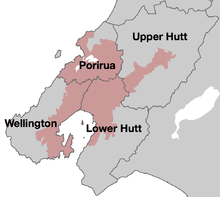
The urban area stretches across the areas administered by the city councils of Wellington, Lower Hutt, Upper Hutt and Porirua. The suburb of Porirua lies on Porirua Harbour to the north. Lower Hutt and Upper Hutt, collectively referred to as the Hutt Valley, are suburban areas to the northeast of Wellington City.
.jpg)
Wellington's scenic natural harbour and green hillsides adorned with tiered suburbs of colonial villas are popular with tourists. The central business district (CBD) is close to Lambton Harbour, an arm of Wellington Harbour, which lies along an active geological fault, clearly evident on its straight western shore. The land to the west of this rises abruptly, meaning that many suburbs sit high above the centre of the city. There is a network of bush walks and reserves maintained by the Wellington City Council and local volunteers. These include Otari-Wilton's Bush, dedicated to the protection and propagation of native plants. The Wellington region has 500 square kilometres (190 sq mi) of regional parks and forests. In the east is the Miramar Peninsula, connected to the rest of the city by a low-lying isthmus at Rongotai, the site of Wellington International Airport. Industry has developed mainly in the Hutt Valley, where there are food-processing plants, engineering industries, vehicle assembly and oil refineries.[32]
The narrow entrance to the harbour is to the east of the Miramar Peninsula, and contains the dangerous shallows of Barrett Reef, where many ships have been wrecked (notably the inter-island ferry TEV Wahine in 1968).[33] The harbour has three islands: Matiu/Somes Island, Makaro/Ward Island and Mokopuna Island. Only Matiu/Somes Island is large enough for habitation. It has been used as a quarantine station for people and animals, and was an internment camp during World War I and World War II. It is a conservation island, providing refuge for endangered species, much like Kapiti Island farther up the coast. There is access during daylight hours by the Dominion Post Ferry.
Wellington is primarily surrounded by water, but some of the nearby locations are listed below.
Relief
Steep landforms shape and constrain much of Wellington city. Notable hills in and around Wellington include:
- Mount Victoria – 196 m. Mt Vic is a popular walk for tourists and Wellingtonians alike, as from the summit one can see most of Wellington. There are numerous mountain bike and walking tracks on the hill.
- Mount Albert[34] – 178 m
- Mount Cook
- Mount Alfred (west of Evans Bay)[35] – 122 m
- Mount Kaukau – 445 m
- Mount Crawford[36]
- Brooklyn Hill – 299 m
- Wrights Hill
- Mākara Hill
- Te Ahumairangi (Tinakori) Hill
Climate
Averaging 2,055 hours of sunshine per year, the climate of Wellington is temperate marine, (Köppen: Cfb), generally moderate all year round with warm summers and mild winters, and rarely sees temperatures above 25 °C (77 °F) or below 4 °C (39 °F). The hottest recorded temperature in the city is 31.1 °C (88 °F), while −1.9 °C (29 °F) is the coldest.[37] The city is notorious for its southerly blasts in winter, which may make the temperature feel much colder. It is generally very windy all year round with high rainfall; average annual rainfall is 1,250 mm (49 in), June and July being the wettest months. Frosts are quite common in the hill suburbs and the Hutt Valley between May and September. Snow is very rare at low altitudes, although snow fell on the city and many other parts of the Wellington region during separate events on 25 July 2011 and 15 August 2011.[38][39]
On 29 January 2019, the suburb of Kelburn reached 30.3 °C (87 °F), the highest temperature since records began in 1927.[40]
| Climate data for Kelburn (1928–2018, Humidity 1962–2018) | |||||||||||||
|---|---|---|---|---|---|---|---|---|---|---|---|---|---|
| Month | Jan | Feb | Mar | Apr | May | Jun | Jul | Aug | Sep | Oct | Nov | Dec | Year |
| Record high °C (°F) | 30.1 (86.2) |
30.1 (86.2) |
28.3 (82.9) |
27.3 (81.1) |
22.0 (71.6) |
18.3 (64.9) |
17.6 (63.7) |
19.3 (66.7) |
21.9 (71.4) |
25.1 (77.2) |
26.9 (80.4) |
29.1 (84.4) |
30.1 (86.2) |
| Average high °C (°F) | 20.1 (68.2) |
20.3 (68.5) |
19.0 (66.2) |
16.6 (61.9) |
14.0 (57.2) |
11.9 (53.4) |
11.1 (52.0) |
11.9 (53.4) |
13.4 (56.1) |
15.0 (59.0) |
16.7 (62.1) |
18.7 (65.7) |
15.7 (60.3) |
| Daily mean °C (°F) | 16.7 (62.1) |
16.9 (62.4) |
15.7 (60.3) |
13.7 (56.7) |
11.3 (52.3) |
9.3 (48.7) |
8.5 (47.3) |
9.2 (48.6) |
10.5 (50.9) |
11.9 (53.4) |
13.4 (56.1) |
15.3 (59.5) |
12.7 (54.9) |
| Average low °C (°F) | 13.2 (55.8) |
13.4 (56.1) |
12.4 (54.3) |
10.7 (51.3) |
8.6 (47.5) |
6.7 (44.1) |
5.9 (42.6) |
6.4 (43.5) |
7.5 (45.5) |
8.8 (47.8) |
10.2 (50.4) |
12.0 (53.6) |
9.6 (49.3) |
| Record low °C (°F) | 4.1 (39.4) |
5.2 (41.4) |
4.6 (40.3) |
2.6 (36.7) |
1.0 (33.8) |
−0.1 (31.8) |
0.0 (32.0) |
−0.1 (31.8) |
0.2 (32.4) |
1.2 (34.2) |
1.7 (35.1) |
3.4 (38.1) |
−0.1 (31.8) |
| Average rainfall mm (inches) | 78.1 (3.07) |
77.9 (3.07) |
85.2 (3.35) |
100.5 (3.96) |
121.0 (4.76) |
132.8 (5.23) |
136.5 (5.37) |
126.4 (4.98) |
100.0 (3.94) |
110.3 (4.34) |
89.7 (3.53) |
91.8 (3.61) |
1,250.3 (49.22) |
| Average rainy days (≥ 1.0 mm) | 7.3 | 7.0 | 8.2 | 9.4 | 11.7 | 13.4 | 13.4 | 13.1 | 11.2 | 11.4 | 9.5 | 9.0 | 124.5 |
| Average relative humidity (%) | 79.5 | 81.6 | 82.2 | 82.7 | 84.5 | 86.0 | 85.8 | 84.6 | 80.7 | 80.3 | 78.9 | 79.5 | 82.2 |
| Mean monthly sunshine hours | 238.8 | 205.1 | 193.7 | 154.0 | 125.8 | 102.3 | 112.0 | 136.6 | 162.1 | 191.5 | 210.4 | 223.0 | 2,055.4 |
| Source: CliFlo[41] | |||||||||||||
| Climate data for Wellington International Airport (1960–2018, Temperature 1962–2018) | |||||||||||||
|---|---|---|---|---|---|---|---|---|---|---|---|---|---|
| Month | Jan | Feb | Mar | Apr | May | Jun | Jul | Aug | Sep | Oct | Nov | Dec | Year |
| Record high °C (°F) | 29.4 (84.9) |
30.6 (87.1) |
28.3 (82.9) |
25.2 (77.4) |
22.0 (71.6) |
19.2 (66.6) |
18.8 (65.8) |
18.3 (64.9) |
22.6 (72.7) |
23.9 (75.0) |
26.8 (80.2) |
29.6 (85.3) |
30.6 (87.1) |
| Average high °C (°F) | 21.1 (70.0) |
21.1 (70.0) |
19.8 (67.6) |
17.3 (63.1) |
15.0 (59.0) |
13.0 (55.4) |
12.2 (54.0) |
12.8 (55.0) |
14.3 (57.7) |
15.8 (60.4) |
17.6 (63.7) |
19.6 (67.3) |
16.7 (62.1) |
| Daily mean °C (°F) | 17.8 (64.0) |
17.8 (64.0) |
16.6 (61.9) |
14.4 (57.9) |
12.3 (54.1) |
10.3 (50.5) |
9.5 (49.1) |
10.1 (50.2) |
11.4 (52.5) |
12.9 (55.2) |
14.5 (58.1) |
16.5 (61.7) |
13.7 (56.7) |
| Average low °C (°F) | 14.5 (58.1) |
14.5 (58.1) |
13.5 (56.3) |
11.5 (52.7) |
9.6 (49.3) |
7.6 (45.7) |
6.7 (44.1) |
7.3 (45.1) |
8.6 (47.5) |
9.9 (49.8) |
11.3 (52.3) |
13.3 (55.9) |
10.7 (51.3) |
| Record low °C (°F) | 4.3 (39.7) |
4.5 (40.1) |
4.3 (39.7) |
2.3 (36.1) |
0.6 (33.1) |
−0.6 (30.9) |
−1.1 (30.0) |
−0.2 (31.6) |
−1.0 (30.2) |
1.2 (34.2) |
2.1 (35.8) |
3.8 (38.8) |
−1.1 (30.0) |
| Average rainfall mm (inches) | 64.2 (2.53) |
56.1 (2.21) |
71.1 (2.80) |
80.5 (3.17) |
94.1 (3.70) |
107.8 (4.24) |
111.7 (4.40) |
102.2 (4.02) |
80.6 (3.17) |
85.1 (3.35) |
69.7 (2.74) |
70.0 (2.76) |
993.0 (39.09) |
| Average rainy days (≥ 1.0 mm) | 6.6 | 6.3 | 7.7 | 8.2 | 10.2 | 12.3 | 12.0 | 12.4 | 10.6 | 10.3 | 8.4 | 8.1 | 113.0 |
| Average relative humidity (%) | 75.1 | 76.8 | 77.6 | 78.0 | 80.0 | 81.5 | 81.0 | 80.0 | 76.5 | 75.4 | 73.6 | 74.9 | 77.5 |
| Source: CliFlo[41] | |||||||||||||
Earthquakes

Wellington suffered serious damage in a series of earthquakes in 1848[42] and from another earthquake in 1855. The 1855 Wairarapa earthquake occurred on the Wairarapa Fault to the north and east of Wellington. It was probably the most powerful earthquake in recorded New Zealand history,[43] with an estimated magnitude of at least 8.2 on the Moment magnitude scale. It caused vertical movements of two to three metres over a large area, including raising land out of the harbour and turning it into a tidal swamp. Much of this land was subsequently reclaimed and is now part of the central business district. For this reason, the street named Lambton Quay is 100 to 200 metres (325 to 650 ft) from the harbour – plaques set into the footpath mark the shoreline in 1840, indicating the extent of reclamation. The 1942 Wairarapa earthquakes caused considerable damage in Wellington.
The area has high seismic activity even by New Zealand standards, with a major fault, the Wellington Fault, running through the centre of the city and several others nearby. Several hundred minor faults lines have been identified within the urban area. Inhabitants, particularly in high-rise buildings, typically notice several earthquakes every year. For many years after the 1855 earthquake, the majority of buildings were made entirely from wood. The 1996-restored Government Buildings[44] near Parliament is the largest wooden building in the Southern Hemisphere. While masonry and structural steel have subsequently been used in building construction, especially for office buildings, timber framing remains the primary structural component of almost all residential construction. Residents place their confidence in good building regulations, which became more stringent in the 20th century. Since the Canterbury earthquakes of 2010 and 2011, earthquake readiness has become even more of an issue, with buildings declared by Wellington City Council to be earthquake-prone,[45][46] and the costs of meeting new standards.[47][48]
Every five years a year-long slow quake occurs beneath Wellington, stretching from Kapiti to the Marlborough Sounds. It was first measured in 2003, and reappeared in 2008 and 2013.[49] It releases as much energy as a magnitude 7 quake, but as it happens slowly there is no damage.[50]
During July and August 2013 there were many earthquakes, mostly in Cook Strait near Seddon. The sequence started at 5:09 pm on Sunday 21 July 2013 when the magnitude 6.5 Seddon earthquake hit the city, but no tsunami report was confirmed nor any major damage.[51] At 2:31 pm on Friday 16 August 2013 the Lake Grassmere earthquake struck, this time magnitude 6.6, but again no major damage occurred, though many buildings were evacuated.[52] On Monday 20 January 2014 at 3:52 pm a rolling 6.2 magnitude earthquake struck the lower North Island 15 km east of Eketahuna and was felt in Wellington, but little damage was reported initially, except at Wellington Airport where one of the two giant eagle sculptures commemorating The Hobbit became detached from the ceiling.[53][54]
At two minutes after midnight on Monday 14 November 2016, the 7.8 magnitude Kaikoura earthquake, which was centred between Culverden and Kaikoura in the South Island, caused the Wellington CBD, Victoria University of Wellington, and the Wellington suburban rail network to be largely closed for the day to allow inspections. The earthquake damaged a considerable number of buildings, with 65% of the damage being in Wellington. Subsequently, a number of recent buildings were demolished rather than being rebuilt, often a decision made by the insurer. Two of the buildings demolished were about eleven years old – the seven-storey NZDF headquarters[55][56] and Statistics House at Centreport on the waterfront.[57] The docks were closed for several weeks after the earthquake.[58]
Demographics
.jpg)
The four cities comprising Greater Wellington have a total population of 424,200 (June 2019),[2] with the urban area containing 98.3% of that population. The remaining areas are largely mountainous and sparsely farmed or parkland and are outside the urban area boundary. More than most cities, life is dominated by its central business district (CBD). Approximately 62,000 people work in the CBD, only 4,000 fewer than work in Auckland's CBD, despite that city having four times the population.
Counts from the 2013 census gave totals by area, gender, and age. Wellington City had the largest population of the four cities with 190,956[59] people, followed by Lower Hutt, Porirua and Upper Hutt. Women outnumbered men in all four areas.[60]

| City | Total | Men | Women |
|---|---|---|---|
| Wellington[59] | 190,956 | 92,481 | 98,478 |
| Lower Hutt[61] | 98,238 | 47,556 | 50,682 |
| Porirua[62] | 51,717 | 24,906 | 26,811 |
| Upper Hutt[63] | 40,179 | 19,770 | 20,409 |
| Total four cities | 381,090 | 184,713 | 196,380 |
Source: Statistics New Zealand (2013 Census)[64]
Quality of living
Wellington ranks 12th in the world for quality of living,[6] according to a 2014 study by consulting company Mercer; of cities in the Asia–Pacific region, Wellington ranked third behind Auckland and Sydney (as of 2014).[6] Wellington has become more affordable in terms of cost of living relative to cities worldwide, with its ranking moving from 93rd (more expensive) to 139th (less expensive) in 2009, probably as a result of currency fluctuations during the global economic downturn from March 2008 to March 2009.[65] "Foreigners get more bang for their buck in Wellington, which is among the cheapest cities in the world to live", according to a 2009 article, which reported that currency fluctuations make New Zealand cities affordable for multinational firms to do business: "New Zealand cities were now more affordable for expatriates and were competitive places for overseas companies to develop business links and send employees".[66]
Culture, religion and identity
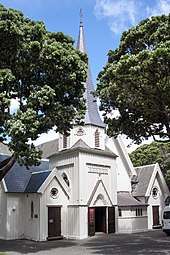
An increasing number of Wellingtonians profess no religious belief, with the most recent census in 2013 showing 44% in that category. The largest religious group was Christians at 39%. The latter figure represented a significant decline from seven years earlier at the previous census, when over 50% of the population identified as Christian.[67][68][69]
At the 2013 Census, just over 27% of Wellington's population was born overseas. The most common overseas birthplace is the United Kingdom, place of origin of 7.1% of the urban area's population. The next most-common countries of origin were Samoa (2.0%), India (1.8%), China (1.7%), Australia (1.6%), the Philippines (1.2%), South Africa (1.1%), Fiji (1.0%), the United States (0.8%) and Malaysia (0.6%).[70][71]
| Ethnicity | 2006 census | 2013 census | 2018 census | |||
|---|---|---|---|---|---|---|
| Number | % | Number | % | Number | % | |
| European | 237,675 | 67.5 | 268,377 | 74.1 | 291,546 | 71.5 |
| Asian | 34,821 | 9.9 | 44,844 | 12.4 | 61,656 | 15.1 |
| Māori | 44,463 | 12.6 | 45,780 | 12.6 | 56,199 | 13.8 |
| Pacific peoples | 32,943 | 9.4 | 33,780 | 9.3 | 39,777 | 9.8 |
| Middle Eastern/Latin American/African | 5,163 | 1.5 | 6,294 | 1.7 | 9,027 | 2.2 |
| Other | 36,750 | 10.4 | 6,276 | 1.7 | 5,766 | 1.9 |
| Total people stated | 351,939 | 361,962 | 407,808 | |||
| Not elsewhere included | 12,189 | 3.5 | 19,131 | 5.3 | 0 | 0.0 |
Age distribution
Age distributions for the four cities are given (see table below). The age structure closely matches the national distribution. The relative lack of older people in Wellington is less marked when Kapiti Coast District is included – nearly 7% of Kapiti Coast residents are over 80.
| City | Under 20 | 20–39 | 40–59 | 60–79 | 80 and over |
|---|---|---|---|---|---|
| Wellington[73] | 47,310 (25%) | 65,823 (34%) | 51,201 (27%) | 22,152 (12%) | 4,470 (2%) |
| Lower Hutt[74] | 27,612 (28%) | 25,344 (26%) | 27,531 (28%) | 14,646 (15%) | 3,108 (3%) |
| Upper Hutt[75] | 10,911 (27%) | 25,344 (23%) | 11,982 (30%) | 6,297 (16%) | 1,608 (4%) |
| Porirua[76] | 16,506 (32%) | 12,873 (25%) | 14,364 (28%) | 6,975 (13%) | 999 (2%) |
| New Zealand[77] | 1,161,384 (27%) | 1,072,893 (25%) | 1,167,570 (27%) | 685,854 (16%) | 154,344 (4%) |
Source: Statistics New Zealand (2013 Census)[78]
Architecture
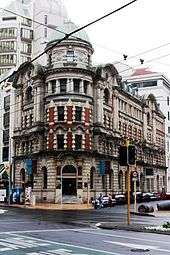
Wellington showcases a variety of architectural styles from the past 150 years – 19th-century wooden cottages (Painted Ladies), such as the Italianate Katherine Mansfield Birthplace in Thorndon; streamlined Art Deco structures such as the old Wellington Free Ambulance headquarters, the Central Fire Station, Fountain Court Apartments, the City Gallery, and the former Post and Telegraph Building; and the curves and vibrant colours of post-modern architecture in the CBD.
The oldest building is the 1858 Colonial Cottage in Mount Cook.[79] The tallest building is the Majestic Centre on Willis Street at 116 metres high, the second tallest being the structural expressionist Aon Centre (Wellington) at 103 metres.[80] Futuna Chapel in Karori was the first bicultural building in New Zealand, and is considered one of the most significant New Zealand buildings of the 20th century.
.jpg)
Old St Paul's is an example of 19th-century Gothic Revival architecture adapted to colonial conditions and materials, as is St Mary of the Angels. Sacred Heart Cathedral is a Palladian Revival Basilica with the Portico of a Roman or Greek temple. The Museum of Wellington City & Sea in the Bond Store is in the Second French Empire style, and the Wellington Harbour Board Wharf Office Building is in a late English Classical style. There are several restored theatre buildings: the St James Theatre, the Opera House and the Embassy Theatre.
Te Ngākau Civic Square is surrounded by the Town Hall and council offices, the Michael Fowler Centre, the Wellington Central Library, Capital E (home of the National Theatre for Children), the City-to-Sea Bridge, and the City Gallery.
As it is the capital city, there are many notable government buildings. The Executive Wing of New Zealand Parliament Buildings, on the corner of Lambton Quay and Molesworth Street, was constructed between 1969 and 1981 and is commonly referred to as the Beehive. Across the road is the largest wooden building in the Southern Hemisphere,[81] part of the old Government Buildings which now houses part of Victoria University of Wellington's Law Faculty.
A modernist building housing the Museum of New Zealand Te Papa Tongarewa lies on the waterfront, on Cable Street. It is strengthened using base isolation[82] – essentially seating the entire building on supports made from lead, steel and rubber that slow down the effect of an earthquake.
Other notable buildings include Wellington Town Hall, Wellington railway station, Dominion Museum (now Massey University), Aon Centre (Wellington), Wellington Regional Stadium, and Wellington Airport at Rongotai. Leading architects include Frederick Thatcher, Frederick de Jersey Clere, W. Gray Young, Bill Alington, Ian Athfield, Roger Walker and Pynenburg and Collins.
Wellington contains many iconic sculptures and structures, such as the Bucket Fountain in Cuba Street and Invisible City by Anton Parsons on Lambton Quay. Kinetic sculptures have been commissioned, such as the Zephyrometer.[83] This 26-metre orange spike built for movement by artist Phil Price has been described as "tall, soaring and elegantly simple", which "reflects the swaying of the yacht masts in the Evans Bay Marina behind it" and "moves like the needle on the dial of a nautical instrument, measuring the speed of the sea or wind or vessel."[84]
Housing and real estate
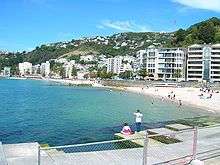
Wellington experienced a real estate boom in the early 2000s and the effects of the international property bust at the start of 2007. In 2005, the market was described as "robust".[85] By 2008, property values had declined by about 9.3% over a 12-month period, according to one estimate. More expensive properties declined more steeply, sometimes by as much as 20%.[86] "From 2004 to early 2007, rental yields were eroded and positive cash flow property investments disappeared as house values climbed faster than rents. Then that trend reversed and yields slowly began improving," according to two The New Zealand Herald reporters writing in May 2009.[87] In the middle of 2009 house prices had dropped, interest rates were low, and buy-to-let property investment was again looking attractive, particularly in the Lambton precinct, according to these two reporters.[87]
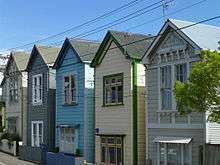
A Wellington City Council survey conducted in March 2009 found the typical central city apartment dweller was a New Zealand native aged 24 to 35 with a professional job in the downtown area, with household income higher than surrounding areas.[88] Three-quarters (73%) walked to work or university, 13% travelled by car, 6% by bus, 2% bicycled (although 31% own bicycles), and did not travel very far since 73% worked or studied in the central city.[88] The large majority (88%) did not have children in their apartments; 39% were couples without children; 32% were single-person households; 15% were groups of people flatting together.[88] Most (56%) owned their apartment; 42% rented (of renters, 16% paid NZ$351 to NZ$450 per week, 13% paid less and 15% paid more – only 3% paid more than NZ$651 per week).[88] The report continued: "The four most important reasons for living in an apartment were given as lifestyle and city living (23%), close to work (20%), close to shops and cafes (11%) and low maintenance (11%) ... City noise and noise from neighbours were the main turnoffs for apartment dwellers (27%), followed by a lack of outdoor space (17%), living close to neighbours (9%) and apartment size and a lack of storage space (8%)."[88][89]
Households are primarily one-family, making up 66.9% of households, followed by single-person households (24.7%); there were fewer multiperson households and even fewer households containing two or more families. These counts are from the 2013 census for the Wellington region (which includes the surrounding area in addition to the four cities).[90]
In December 2019, Quotable Value reported the average house price for Wellington metro was $747,000, ranging from $603,000 in Upper Hutt to $978,000 in the western suburbs of Wellington City.[91]
Economy

Wellington Harbour ranks as one of New Zealand's chief seaports and serves both domestic and international shipping. The port handles approximately 10.5 million tonnes of cargo on an annual basis,[92] importing petroleum products, motor vehicles, minerals and exporting meats, wood products, dairy products, wool, and fruit. Many cruise ships also use the port.
The Government sector has long been a mainstay of the economy, which has typically risen and fallen with it. Traditionally, its central location meant it was the location of many head offices of various sectors – particularly finance, technology and heavy industry – many of which have since relocated to Auckland following economic deregulation and privatisation.[93][94]
In recent years, tourism, arts and culture, film, and ICT have played a bigger role in the economy. Wellington's median income is well above the average in New Zealand,[95] and the highest of all New Zealand cities.[96] It has a much higher proportion of people with tertiary qualifications than the national average.[97] Major companies with their headquarters in Wellington include:
At the 2013 census, the largest employment industries for Wellington residents were professional, scientific and technical services (25,836 people), public administration and safety (24,336 people), health care and social assistance (17,446 people), education and training (16,550 people) and retail trade (16,203 people).[98] In addition, Wellington is an important centre of the New Zealand film and theatre industry, and second to Auckland in terms of numbers of screen industry businesses.[99]
Tourism
Tourism is a major contributor to the city's economy, injecting approximately NZ$1.3 billion into the region annually and accounting for 9% of total FTE employment.[100] The city is consistently named as New Zealanders' favourite destination in the quarterly FlyBuys Colmar Brunton Mood of the Traveller survey[101] and it was ranked fourth in Lonely Planet Best in Travel 2011's Top 10 Cities to Visit in 2011.[102] New Zealanders make up the largest visitor market, with 3.6 million visits each year; New Zealand visitors spend on average NZ$2.4 million a day.[103] There are approximately 540,000 international visitors each year, who spend 3.7 million nights and NZ$436 million. The largest international visitor market is Australia, with over 210,000 visitors spending approximately NZ$334 million annually.[104]
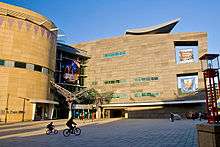
It has been argued that the construction of the Te Papa museum helped transform Wellington into a tourist destination.[105] Wellington is marketed as the 'coolest little capital in the world' by Positively Wellington Tourism, an award-winning regional tourism organisation[106] set up as a council controlled organisation by Wellington City Council in 1997.[107] The organisation's council funding comes through the Downtown Levy commercial rate.[108] In the decade to 2010, the city saw growth of over 60% in commercial guest nights. It has been promoted through a variety of campaigns and taglines, starting with the iconic Absolutely Positively Wellington advertisements.[109] The long-term domestic marketing strategy was a finalist in the 2011 CAANZ Media Awards.[110]
Popular tourist attractions include Wellington Museum, Wellington Zoo, Zealandia and Wellington Cable Car. Cruise tourism is experiencing a major boom in line with nationwide development. The 2010/11 season saw 125,000 passengers and crew visit on 60 liners. There were 80 vessels booked for visits in the 2011/12 season – estimated to inject more than NZ$31 million into the economy and representing a 74% increase in the space of two years.[111]
Wellington is a popular conference tourism destination due to its compact nature, cultural attractions, award-winning restaurants and access to government agencies. In the year ending March 2011, there were 6495 conference events involving nearly 800,000 delegate days; this injected approximately NZ$100 million into the economy.[112]
Arts and culture
Museums and cultural institutions
Wellington is home to many cultural institutions, including Te Papa (the Museum of New Zealand), the National Library of New Zealand, Archives New Zealand, Wellington Museum (formerly the Wellington Museum of City and Sea), the Katherine Mansfield House and Garden (formerly Katherine Mansfield Birthplace), Colonial Cottage, the Wellington Cable Car Museum, the Reserve Bank Museum, Old St Paul's, the National War Memorial[5] and the Wellington City Gallery.
Festivals
Wellington is home to many high-profile events and cultural celebrations, including the biennial New Zealand International Arts Festival, biennial Wellington Jazz Festival, biennial Capital E National Arts Festival for Children and major events such as Brancott Estate World of Wearable Art, TEDxWellington, Cuba Street Carnival, Visa Wellington on a Plate, New Zealand Fringe Festival, New Zealand International Comedy Festival (also hosted in Auckland), Summer City, The Wellington Folk Festival[113] (in Wainuiomata), New Zealand Affordable Art Show, the New Zealand Sevens Weekend and Parade, Out In The Square, Vodafone Homegrown, the Couch Soup theatre festival, Camp A Low Hum and numerous film festivals.
The annual children's Artsplash Festival brings together hundreds of students from across the region. The week-long festival includes music and dance performances and the presentation of visual arts.[114]
Film
Filmmakers Sir Peter Jackson, Sir Richard Taylor and a growing team of creative professionals have turned the eastern suburb of Miramar into a film-making, post-production and special effects infrastructure centre, giving rise to the moniker 'Wellywood'.[115][116] Jackson's companies include Weta Workshop, Weta Digital, Camperdown Studios, post-production house Park Road Post, and Stone Street Studios near Wellington Airport.[117][118] Recent films shot partly or wholly in Wellington include the Lord of The Rings trilogy, King Kong and Avatar. Jackson described Wellington: "Well, it's windy. But it's actually a lovely place, where you're pretty much surrounded by water and the bay. The city itself is quite small, but the surrounding areas are very reminiscent of the hills up in northern California, like Marin County near San Francisco and the Bay Area climate and some of the architecture. Kind of a cross between that and Hawaii."[119]
Sometime Wellington directors Jane Campion and Geoff Murphy have reached the world's screens with their independent spirit. Emerging Kiwi filmmakers, like Robert Sarkies, Taika Waititi, Costa Botes and Jennifer Bush-Daumec,[120] are extending the Wellington-based lineage and cinematic scope. There are agencies to assist film-makers with tasks such as securing permits and scouting locations.[121]
Wellington has a large number of independent cinemas, including The Embassy, Penthouse, the Roxy and Light House, which participate in film festivals throughout the year. Wellington has one of the country's highest turn-outs for the annual New Zealand International Film Festival.
Music
The music scene has produced bands such as The Warratahs, The Mockers, The Phoenix Foundation, Shihad, Beastwars, Fly My Pretties, Rhian Sheehan, Birchville Cat Motel, Black Boned Angel, Fat Freddy's Drop, The Black Seeds, Fur Patrol, Flight of the Conchords, Connan Mockasin, Rhombus and Module, Weta, Demoniac. The New Zealand School of Music was established in 2005 through a merger of the conservatory and theory programmes at Massey University and Victoria University of Wellington. New Zealand Symphony Orchestra, Nevine String Quartet and Chamber music New Zealand are based in Wellington. The city is also home to the Rodger Fox Big Band and the Internationally renowned men's A Cappella chorus Vocal FX.
Theatre and the dramatic arts

Wellington is home to BATS Theatre, Circa Theatre, the National Maori Theatre company Taki Rua, Whitireia Performance Centre, National Dance & Drama School Toi Whakaari and the National Theatre for Children at Capital E in Civic Square. St James' Theatre on Courtenay Place is a popular venue for artistic performances.
Wellington is home to groups that perform Improvised Theatre and Improvisational comedy, including Wellington Improvisation Troupe (WIT) an Improvisors and youth group, Joe Improv. Te Whaea National Dance & Drama Centre, houses New Zealand's University-level school of Dance and Drama, Toi Whakaari: NZ Drama School & New Zealand School of Dance, and Whitireia Performing Arts Centre. These are separate entities that share the building's facilities.
Dance
Wellington is the home for the Royal New Zealand Ballet, the New Zealand School of Dance and contemporary dance company Footnote.
Comedy
Many of New Zealand's prominent comedians have either come from Wellington or got their start there, such as Ginette McDonald ("Lyn of Tawa"), Raybon Kan, Dai Henwood, Ben Hurley, Steve Wrigley, Guy Williams, the Flight of the Conchords and the satirist John Clarke ("Fred Dagg").
The comedy group Breaking the 5th Wall[122] operated out of Wellington and regularly did shows around the city, performing a mix of sketch comedy and semi-improvised theatre. In 2012 the group disbanded when some of its members moved to Australia.
Wellington is home to groups that perform improvised theatre and improvisational comedy, including Wellington Improvisation Troupe (WIT), The Improvisors and youth group Joe Improv.
Wellington hosts shows in the annual New Zealand International Comedy Festival.[123]
Visual arts
From 1936 to 1992 Wellington was home to the National Art Gallery of New Zealand, when it was amalgamated into Museum of New Zealand Te Papa Tongarewa. Wellington is home to the New Zealand Academy of Fine Arts and the Arts Foundation of New Zealand. The city's arts centre, Toi Pōneke, is a nexus of creative projects, collaborations, and multi-disciplinary production. Arts Programmes and Services Manager Eric Vaughn Holowacz and a small team based in the Abel Smith Street facility have produced ambitious initiatives such as Opening Notes, Drive by Art, and public art projects. The city is home to experimental arts publication White Fungus. The Learning Connexion provides art classes. Other visual art galleries include the City Gallery.
- Te Ngākau Civic Square with the Ferns artwork suspended above


Cuisine
Wellington is characterised by small dining establishments, and its café culture is internationally recognised, being known for its large number of coffeehouses.[124][125] Restaurants offer cuisines including from Europe, Asia and Polynesia; for dishes that have a distinctly New Zealand style, there are lamb, pork and cervena (venison), salmon, crayfish (lobster), Bluff oysters, pāua (abalone), mussels, scallops, pipis and tuatua (both New Zealand shellfish); kumara (sweet potato); kiwifruit and tamarillo; and pavlova, the national dessert.[126]
Sport
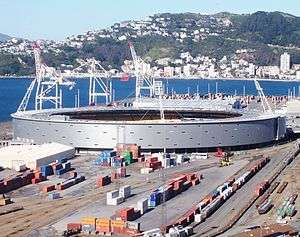
Wellington is the home to:
- Hurricanes – Super Rugby team based in Wellington
- Wellington Lions – ITM Cup rugby team
- Wellington Phoenix FC – football (soccer) club playing in the Australasian A-League, the only fully professional football club in New Zealand
- Team Wellington – in the semi-professional New Zealand Football Championship
- Central Pulse – netball team representing the Lower North Island in the ANZ Championship, primarily based in Wellington
- Wellington Firebirds and Wellington Blaze – men's and women's cricket teams
- Wellington Saints – basketball team in the National Basketball League
Sporting events include:
- six pool games and two quarter-final games at the 2011 Rugby World Cup
- the Wellington Sevens – a round of the IRB Sevens World Series held at the Wellington Regional Stadium over several days every February.
- the 2011 Tae Kwon Do World Champs
- The 2014 World Field Target Championships
- the World Mountain Running Championships in 2005
- the Wellington 500 street race for touring cars, between 1985 and 1996
Government
Local
The Wellington urban area lies within four territorial authorities: Wellington City, Porirua, Lower Hutt and Upper Hutt. Wellington is also part of the wider Wellington Region, administered by the Greater Wellington Region Council. The local authorities are responsible for a wide variety of public services, which include management and maintenance of local roads, and land-use planning.[127]
National
Wellington is covered by six general electorates: Hutt South, Mana, Ōhāriu, Rimutaka, Rongotai, and Wellington Central. It is also covered by three Māori electorates: Ikaroa-Rāwhiti, Te Tai Hauāuru, and Te Tai Tonga. Each electorate returns one member to the New Zealand House of Representatives. All electorates except Hutt South are held by the governing Labour Party. Hutt South is held by the opposition National Party.
In addition, there are a varying number of Wellington-based list MPs, who are elected via party lists. As of September 2018, there are five list MPs in the House who contested Wellington-based electorates at the 2017 election: two from National, two from Green, and one from Labour. The Speaker of the House, Trevor Mallard, is also a Wellington-based list MP having previously held Hutt South.
Due to Wellington being the capital city of New Zealand, its residents are more likely to participate in politics compared to other cities in New Zealand.[5]
Education
Wellington offers a variety of college and university programs for tertiary students:
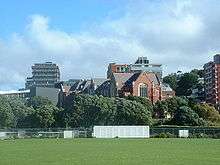
Victoria University of Wellington has four campuses and works with a three-trimester system (beginning March, July, and November).[128] It enrolled 21,380 students in 2008; of these, 16,609 were full-time students. Of all students, 56% were female and 44% male. While the student body was primarily New Zealanders of European descent, 1,713 were Maori, 1,024 were Pacific students, 2,765 were international students. 5,751 degrees, diplomas and certificates were awarded. The university has 1,930 full-time employees.[129]
Massey University has a Wellington campus known as the "creative campus" and offers courses in communication and business, engineering and technology, health and well-being, and creative arts. Its school of design was established in 1886 and has research centres for studying public health, sleep, Maori health, small & medium enterprises, disasters, and tertiary teaching excellence.[130] It combined with Victoria University to create the New Zealand School of Music.[130]
The University of Otago has a Wellington branch with its Wellington School of Medicine and Health.
Whitireia New Zealand has large campuses in Porirua, Wellington and Kapiti; the Wellington Institute of Technology and New Zealand's National Drama school, Toi Whakaari. For further information, see List of universities in New Zealand. The Wellington area has numerous primary and secondary schools.
Transport
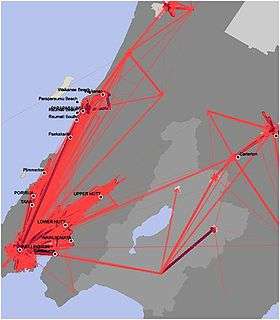
Wellington is served by State Highway 1 in the west and State Highway 2 in the east, meeting at the Ngauranga Interchange north of the city centre, where SH 1 runs through the city to the airport. Road access into the capital is constrained by the mountainous terrain – between Wellington and the Kapiti Coast, SH 1 travels along the Centennial Highway, a narrow section of road, and between Wellington and Wairarapa SH 2 transverses the Rimutaka Ranges on a similar narrow winding road. Wellington has two motorways, both part of SH 1: the Johnsonville–Porirua Motorway and the Wellington Urban Motorway, which in combination with a small non-motorway section in the Ngauranga Gorge connect Porirua with Wellington city.
Bus transport in Wellington is supplied by several different operators under the banner of Metlink. Buses serve almost every part of Wellington city, with most of them running along the "Golden Mile" from Wellington railway station to Courtenay Place. Until October 2017 there were nine trolleybus routes, all other buses running on diesel. The trolleybus network was the last public system of its kind in the southern hemisphere.
Wellington lies at the southern end of the North Island Main Trunk railway (NIMT) and the Wairarapa Line, converging on Wellington railway station at the northern end of central Wellington. Two long-distance services leave from Wellington: the Capital Connection, for commuters from Palmerston North, and the Northern Explorer to Auckland.
Four electrified suburban lines radiate from Wellington railway station to the outer suburbs to the north of Wellington – the Johnsonville Line through the hillside suburbs north of central Wellington; the Kapiti Line along the NIMT to Waikanae on the Kapiti Coast via Porirua and Paraparaumu; the Melling Line to Lower Hutt via Petone; and the Hutt Valley Line along the Wairarapa Line via Waterloo and Taitā to Upper Hutt. A diesel-hauled carriage service, the Wairarapa Connection, connects several times daily to Masterton in the Wairarapa via the 8.8-kilometre-long (5.5 mi) Rimutaka Tunnel. Combined, these five services carry 11.64 million passengers per year.[132]
Wellington is the North Island port for Cook Strait ferries to Picton in the South Island, provided by state-owned Interislander and private Bluebridge. Local ferries connect Wellington city centre with Eastbourne and Seatoun.[133]
Wellington International Airport is 6 kilometres (3.7 mi) south-east of the city centre. It is serviced by flights from across New Zealand, Australia, Singapore and Fiji. Flights to other international destinations require a transfer at another airport, as larger aircraft cannot use Wellington's short (2,081-metre or 6,827-foot) runway, which has become an issue in recent years in regards to the Wellington region's economic performance.[134][135]
Infrastructure
Electric power
Wellington's first public electricity supply was established in 1904, alongside the introduction of electric trams, and was originally supplied at 105 volts 80 hertz. The conversion to the now-standard 230/400 volts 50 hertz began in 1925, the same year the city was connected to the Mangahao hydroelectric scheme. Between 1924 and 1968, the city's supply was supplemented by a coal-fired power station at Evans Bay.[136]
Today, Wellington is supplied from nine Transpower substations, however the design of the transmission system means that the city is ultimately fed by only two Transpower substations: Haywards and Wilton. Wellington Electricity owns and operates the local distribution network.
The city is home to two large wind farms, West Wind and Mill Creek, which combined contribute up to 213 MW of electricity to the city and the national grid. Haywards substation in Lower Hutt is the site of the HVDC Inter-Island's North Island converter station; the HVDC link connects the North and South Island grids together and allows surplus South Island hydroelectricity to be transmitted the North Island's electricity demand.
While Wellington experiences regular strong winds, and only 63% of Wellington Electricity's network is underground, the city has a very reliable power supply. In the year to March 2018, Wellington Electricity disclosed the average customer spent just 55 minutes without power due to unplanned outages.[137]
Natural gas
Wellington and the Hutt Valley were two of the original nine towns and cities in New Zealand to be supplied with natural gas when the Kapuni gas field entered production in 1970, and a 260-kilometre-long (160 mi) high-pressure pipeline from the field in Taranaki to the city was completed. The high-pressure transmission pipelines supplying Wellington are now owned and operated by First Gas, with Powerco owning and operating the medium- and low-pressure distribution pipelines within the urban area.[138]
The three waters
The "three waters" – drinking water, stormwater, and wastewater services for Wellington are provided by five councils: Wellington City, Hutt, Upper Hutt and Porirua city councils, and the Greater Wellington Regional Council. However, the water assets of these councils are managed by an infrastructure asset management company, Wellington Water.
Wellington's first piped water supply came from a spring in 1867.[139] Greater Wellington Regional Council now supplies Lower Hutt, Porirua, Upper Hutt and Wellington with up to 220 million litres a day.[140] The water comes from Wainuiomata River (since 1884), Hutt River (1914), Orongorongo River (1926) and the Lower Hutt aquifer.[141]
There are four wastewater treatment stations serving the region, located at:[142]
- Moa Point (serving Wellington city)
- Seaview (serving Lower Hutt and Upper Hutt)
- Karori (serving the suburb)
- Porirua (serving northern Wellington suburbs, Tawa and Porirua city)
The city faces challenges with ageing infrastructure for the three waters and there have been some significant failures, particularly in wastewater systems. The water supply is vulnerable to severe disruption during a major earthquake, although a wide range of projects are planned to improve resilience of the water supply and allow a limited water supply post-earthquake.[143][144]
Twin cities
Wellington is twinned with the following cities:[145]
- Sydney, Australia (1983)
- Xiamen, People's Republic of China (1987)
- Sakai, Japan (1994)
- Beijing, People's Republic of China (2006)
- Canberra, Australia (2016)
It also has historical ties with Chania, Greece; Harrogate, England; and Çanakkale, Turkey.[146]
See also
References
- "About Wellington – Facts & Figures". Wellington City Council. Archived from the original on 17 September 2011. Retrieved 5 August 2008.
- "Subnational Population Estimates: At 30 June 2019". Statistics New Zealand. 22 October 2019. Retrieved 11 January 2020.
- Guinness World Records 2009. London, United Kingdom: Guinness World Records Ltd. 2008. p. 277. ISBN 978-1-904994-36-7.
- Karl Mathiesen (15 October 2015). "Where is the world's windiest city? Spoiler alert: it's not Chicago". The Guardian. Archived from the original on 12 July 2016. Retrieved 13 August 2016.
- Levine, Stephen (20 June 2012). "Capital city – Wellington, capital city". Te Ara: The Encyclopedia of New Zealand. Archived from the original on 5 February 2019. Retrieved 23 May 2019.
- "2014 Quality of Living Worldwide City Rankings – Mercer Survey". www.mercer.com. 19 February 2014. Archived from the original on 25 June 2013. Retrieved 11 April 2014.
- "Wellington named most liveable city for second year running". Stuff. Archived from the original on 23 June 2019. Retrieved 23 June 2019.
- Lim, Jason (29 November 2015). "Wellington Is Bigger On Tech And Innovation Than You Think". Forbes. Retrieved 15 November 2016.
- Noted. "How they saw us: 250 years of quotes about New Zealand". Noted. Archived from the original on 9 July 2019. Retrieved 9 July 2019.
- "Wellington is a Smart City of the future". iStart leading the way to smarter technology investment. Archived from the original on 9 July 2019. Retrieved 9 July 2019.
- "GaWC - The World According to GaWC 2018". www.lboro.ac.uk. Retrieved 19 July 2020.
- "Huffington Post lauds Wellington's 'remarkable' creative resurgence". Stuff. Archived from the original on 9 July 2019. Retrieved 9 July 2019.
- "Wellington: New Zealand's creative capital". TNZ Media. Archived from the original on 9 July 2019. Retrieved 9 July 2019.
- Wakefield, Edward Jerningham (1845). Adventure in New Zealand, Vol. 1, pub. John Murray.
- Love, Morris (3 March 2017). "Te Āti Awa of Wellington". Te Ara – the Encyclopedia of New Zealand. Retrieved 28 October 2019.
- "Poneke: Wellington places to visit". Department of Conservation. 20 February 2007. Archived from the original on 20 February 2007. Retrieved 19 June 2015.
- "Māori history". Wellington City Council. Archived from the original on 10 April 2019. Retrieved 9 July 2019.
- Maclean, Chris (1 August 2015). "Wellington region – Early Māori history". Te Ara – the Encyclopedia of New Zealand. Retrieved 28 October 2019.
- "Wellington – New Zealand Sign Language Online". Deaf Studies Research Unit, Victoria University of Wellington. Retrieved 11 November 2013.
- Maclean, Chris (1 August 2015). "Wellington region – Climate: Windy Wellington". Te Ara: The Encyclopedia of New Zealand. Retrieved 28 October 2019.
- Waitangi Tribunal. (2003). Te Whanganui a Tara me ona takiwa : report on the Wellington District. Wellington, N.Z.: Legislation Direct. p. 17. ISBN 186956264X. OCLC 53261192.
- Waitangi Tribunal (2003). Te Whanganui a Tara me ona takiwa : report on the Wellington District. Wellington, N.Z.: Legislation Direct. p. 13. ISBN 186956264X. OCLC 53261192.
- Waitangi Tribunal, Te Whanganui a Tara me ona Takiwa, page 18, https://forms.justice.govt.nz/search/Documents/WT/wt_DOC_68452530/Wai145.pdf Archived 22 January 2019 at the Wayback Machine
- Waitangi Tribunal, Te Whanganui a Tara me ona Takiwa, page 18
- Waitangi Tribunal (2003). Te Whanganui a Tara me ona takiwa : report on the Wellington District. Wellington, N.Z.: Legislation Direct. ISBN 186956264X. OCLC 53261192.
- "Deed of Settlement of Historical Claims signed between Taranaki Whānui ki Te Upoko o Te Ika and the Port Nicholson Block Settlement Trust and The Sovereign in Right of New Zealand" (PDF). New Zealand Government. 19 August 2008. p. 8. Archived from the original (PDF) on 4 February 2018. Retrieved 15 September 2018.
The importance of the Harbour to Taranaki Whanui ki Te Upoko o Te Ika increased as trade was entered into early in the 19th century.
- "History of New Zealand, 1769–1914 – A history of New Zealand 1769–1914". nzhistory.govt.nz. Ministry for Culture and Heritage. Archived from the original on 20 July 2019. Retrieved 10 July 2019.
- "Parliament moves to Wellington". nzhistory.govt.nz. Ministry for Culture and Heritage. Archived from the original on 25 April 2019. Retrieved 25 April 2019.
- Temple, Philip (1980). Wellington Yesterday. John McIndoe. ISBN 0-86868-012-5.
- Maclean, Chris (9 July 2007). "Wellington region – Boom and bust: 1900–1940". Te Ara: The Encyclopedia of New Zealand. Archived from the original on 20 July 2019. Retrieved 23 May 2019.
- Karl Mathiesen. "Where is the world's windiest city? Spoiler alert: it's not Chicago". The Guardian. Archived from the original on 19 January 2016. Retrieved 19 January 2016.
- Paxton, John, ed. (1999). "Wellington, New Zealand". The Penguin Encyclopedia of Places (3rd ed.) – via Credo Reference.
- "New Zealand Disasters – Wahine Shipwreck". Christchurch City Libraries. 10 April 1968. Archived from the original on 19 August 2011. Retrieved 28 July 2009.
- Harper, Laura; Mudd, Tony; Whitfield, Paul (2002). New Zealand. Rough Guide Travel Guides. Rough Guides. p. 504. ISBN 9781858288963. Archived from the original on 24 February 2017. Retrieved 9 August 2016.
Highlights include the sweeping views from the lookout at the Mount Victoria summit (196m) and from Mount Albert (178m) [...].
- Wise's New Zealand Index. H. Wise & Co. (N.Z.) Ltd. 1948. p. 245. Archived from the original on 24 February 2017. Retrieved 9 August 2016.
Mount Alfred. West of Evans Bay, Wellington; 400ft.
- Wake, Jenny (2005). The Making of King Kong: The Official Guide to the Motion Picture. New York: Simon and Schuster. p. 111. ISBN 9781416505181. Archived from the original on 24 February 2017. Retrieved 9 August 2016.
The native village and wall set, too big to build in a soundstage, was erected outside on nearby Mount Crawford, a hill overlooking Wellington harbor.
- "Climate Summary". MetService. Archived from the original on 22 January 2019. Retrieved 31 January 2019.
- "Snow spotted in central Wellington". The Dominion Post. 25 July 2011. Archived from the original on 25 October 2012. Retrieved 1 August 2011.
- "Snow falls in downtown Wellington". The Dominion Post. 15 August 2011. Archived from the original on 25 October 2012. Retrieved 15 August 2011.
- "Temperature record broken in Wellington, warm weather to last to weekend". The New Zealand Herald. 29 January 2019. Archived from the original on 29 January 2019. Retrieved 29 January 2019.
- "CliFlo – National Climate Database". NIWA. Archived from the original on 27 November 2015. Retrieved 31 January 2019.
- "The 1848 Marlborough earthquake – Te Ara: The Encyclopedia of New Zealand". Teara.govt.nz. 30 March 2005. Archived from the original on 2 June 2009. Retrieved 6 February 2009.
- "The 1855 Wairarapa earthquake – Te Ara: The Encyclopedia of New Zealand". Teara.govt.nz. 21 September 2007. Archived from the original on 21 February 2009. Retrieved 6 February 2009.
- "Government Buildings". Register of Historic Places. Heritage New Zealand. Retrieved 6 February 2009.
- Dave Burgess (14 March 2011). "Shuddering in Wellington". Fairfax NZ. Archived from the original on 23 March 2011. Retrieved 28 October 2012.
- Hank Schouten (2 June 2012). "How safe are the capital's office buildings?". Dominion Post. Archived from the original on 4 June 2012. Retrieved 28 October 2012.
- Kate Chapman (16 October 2012). "Councillors question quake costs". The Dominion Post. Archived from the original on 19 October 2012. Retrieved 28 October 2012.
- Dave Burgess & Hank Schouten (1 October 2011). "Quake shakes capital insurance market". The Dominion Post. Archived from the original on 24 October 2012. Retrieved 28 October 2012.
- "'Silent' quake gently rocks Wellington". 3 News NZ. 28 May 2013. Archived from the original on 23 August 2014. Retrieved 28 May 2013.
- "M7 slow release earthquake under Wellington". GeoNet NZ. 27 May 2013. Archived from the original on 7 June 2013. Retrieved 28 May 2013.
- "New Zealand's capital shaken by a magnitude 6.5 earthquake". ABC News. 21 July 2013. Archived from the original on 22 July 2013. Retrieved 21 July 2013.
- Strong 6.6 earthquake hits Wellington, aftershocks... Archived 13 October 2013 at the Wayback Machine. Stuff.co.nz. Retrieved on 7 September 2013.
- "6.2 earthquake cuts power, phones, stops trains". One News. 20 January 2014. Archived from the original on 16 May 2015. Retrieved 21 June 2015.
- "Quake: 'Hobbit' sculpture crashes down at N.Z. airport". USA Today. 20 January 2014. Archived from the original on 27 December 2017. Retrieved 21 November 2016.
- "Defence House in Wellington to be demolished after investigations show repairs to earthquake damage uneconomic". The New Zealand Herald. 3 March 2017. Archived from the original on 28 September 2018. Retrieved 16 May 2018.
- "Freyberg House to be demolished". Stuff (Fairfax). 3 March 2017. Archived from the original on 9 January 2018. Retrieved 16 May 2018.
- "Unacceptable performance of building says Minister". Stuff (Fairfax). 26 July 2017. Archived from the original on 10 January 2018. Retrieved 16 May 2018.
- "Maersk to return to Wellington when CentrePort's cranes are repaired". Stuff.co.nz. 31 July 2017. Archived from the original on 28 September 2018. Retrieved 28 September 2018.
- "Tables about a place". stats.govt.nz. Archived from the original on 13 November 2014. Retrieved 24 November 2014.
- "Tables about a place". stats.govt.nz. Archived from the original on 14 November 2014. Retrieved 24 November 2014.
- "Tables about a place". stats.govt.nz. Archived from the original on 13 November 2014. Retrieved 24 November 2014.
- "Tables about a place". stats.govt.nz. Archived from the original on 13 November 2014. Retrieved 24 November 2014.
- "Tables about a place". stats.govt.nz. Archived from the original on 13 November 2014. Retrieved 24 November 2014.
- "2013 Census". Statistics New Zealand. Archived from the original on 29 June 2015. Retrieved 21 June 2015.
- "Worldwide Cost of Living survey 2009–City ranking released–Mercer survey". Archived from the original on 8 June 2009. Retrieved 27 July 2009.
- Kelly Burns (7 August 2009). "You get more for your money in Wellington". The Dominion Post. Archived from the original on 8 January 2010. Retrieved 1 August 2009.
- "Religion | Wellington City | profile.id". profile.idnz.co.nz. Archived from the original on 16 October 2015. Retrieved 19 June 2015.
- "'No religion' is now capital's most popular – NewsWire.co.nz". www.newswire.co.nz. Archived from the original on 16 October 2015. Retrieved 19 June 2015.
- "Census 2013: Data reveals most religious region". The New Zealand Herald. 4 February 2014. ISSN 1170-0777. Archived from the original on 24 April 2015. Retrieved 19 June 2015.
- "2013 Census QuickStats about culture and identity – Birthplace and people born overseas". Statistics New Zealand. Archived from the original on 12 July 2014. Retrieved 16 August 2014.
- "NZ.Stat". Statistics New Zealand. Retrieved 16 August 2014.
- "Ethnic group (detailed total response - level 3) by age and sex, for the census usually resident population count, 2006, 2013, and 2018 Censuses (RC, TA, SA2, DHB)". nzdotstat.stats.govt.nz. Retrieved 3 March 2020.
- "Age and sex of people in Wellington City – 2013 Census". stats.govt.nz. Statistics New Zealand. Archived from the original on 21 June 2015. Retrieved 21 June 2015.
- "Age and sex of people in Lower Hutt City – 2013 Census". stats.govt.nz. Statistics New Zealand. Archived from the original on 21 June 2015. Retrieved 21 June 2015.
- "Age and sex of people in Upper Hutt City – 2013 Census". stats.govt.nz. Statistics New Zealand. Archived from the original on 21 June 2015. Retrieved 21 June 2015.
- "Age and sex of people in Porirua City – 2013 Census". stats.govt.nz. Statistics New Zealand. Archived from the original on 21 June 2015. Retrieved 21 June 2015.
- "Age and sex of people in New Zealand – 2013 Census". stats.govt.nz. Statistics New Zealand. Archived from the original on 21 June 2015. Retrieved 21 June 2015.
- "2013 Census". Statistics New Zealand. Archived from the original on 29 June 2015. Retrieved 21 June 2015.
- "Colonial Cottage". Colonialcottagemuseum.co.nz. Retrieved 6 February 2009.
- "Emporis.com". Emporis.com. 11 November 2006. Archived from the original on 30 September 2007. Retrieved 6 February 2009.
- "Department of Conservation". Doc.govt.nz. 29 August 2006. Archived from the original on 10 February 2013. Retrieved 6 February 2009.
- "Base Isolation" (PDF). Archived from the original (PDF) on 19 March 2013. Retrieved 10 April 2013.
- "Kinetic Sculpture by Tony Nicholls – Enjoy Public Art Gallery". Texture – Wellington, New Zealand. 23 September 2008. Archived from the original on 30 September 2008. Retrieved 28 July 2009.
- "Zephyrometer – The second of the Meridian Energy wind sculptures". Wellington Sculpture Trust. 1 August 2014. Archived from the original on 1 August 2014. Retrieved 20 June 2015.
- Anne Gibson (3 August 2005). "Robust market sprouts apartments". The New Zealand Herald. Archived from the original on 5 January 2012. Retrieved 29 July 2009.
- Andrea Milner (21 June 2009). "Post properties get biggest pounding". The New Zealand Herald. Archived from the original on 5 January 2012. Retrieved 29 July 2009.
- Andrea Milner and Jonathan Milne (10 May 2009). "Real Estate: Rental buys looking good". The New Zealand Herald. Archived from the original on 30 August 2011. Retrieved 29 July 2009.
- "Central City Apartment Dwellers Survey – a summary of results" (PDF). Wellington Government. March 2009. Archived (PDF) from the original on 11 January 2014. Retrieved 11 January 2014.
- "It's a great life downtown ... except for the noise". The New Zealand Herald. 14 April 2009. Archived from the original on 5 January 2012. Retrieved 29 July 2009.
- 2013 Census QuickStats about a place : Wellington Region
- "Residential house values". Quotable Value. Archived from the original on 19 November 2016. Retrieved 13 July 2018.
- "Frequently Asked Questions". www.centreport.co.nz. Archived from the original on 11 February 2017. Retrieved 10 February 2017.
- "The Encyclopedia of NZ – Economic fall and rise: 1976–2006". Te Ara. 13 July 2012. Archived from the original on 5 September 2013. Retrieved 16 September 2013.
- Terry Hall (23 July 2012). "Wellington businesses are fighting back". The Dominion Post. Archived from the original on 25 August 2012. Retrieved 28 October 2012.
- "Living in Wellington". Careers New Zealand. 19 December 2008. Archived from the original on 19 December 2008. Retrieved 19 June 2015.
- "Comparison of New Zealand cities". Emigrate New Zealand. 2006. Archived from the original on 23 February 2012. Retrieved 26 February 2012.
- "Wellington Facts & Figures – Census Summaries – 2006 – Occupation & Qualifications – New Zealand". Statistics New Zealand. 10 February 2013. Archived from the original on 10 February 2013. Retrieved 19 June 2015.
- "2013 Census QuickStats about work and unpaid activities". Statistics New Zealand. 31 March 2015. Archived from the original on 15 November 2015. Retrieved 21 May 2017.
- "Screen Industry Survey: 2007/08 – (spreadsheet – see pages 5, 8)". Statistics New Zealand. 2008. Archived from the original on 8 August 2009. Retrieved 1 August 2009.
- BERL Economics, 2011
- "Mood of the Traveller". www.tianz.org.nz. Archived from the original on 25 April 2011. Retrieved 6 May 2011.
- "Lonely Planet Names Wellington One of 2011's Top 10 Cities". Lonely Planet. 1 November 2010. Archived from the original on 16 October 2015. Retrieved 30 July 2015.
- "Wellington RTO Tourism Forecasts". www.tourism.govt.nz. Archived from the original on 26 April 2011. Retrieved 6 May 2011.
- "International Visitor Survey". www.tourismresearch.govt.nz. Archived from the original on 29 April 2011. Retrieved 6 May 2011.
- Kaino, Lorna (2005). "What Difference Does a Museum Make? TE Papa's Contribution to the New Zealand Economy". Media International Australia Incorporating Culture and Policy. 117 (1): 31–42. doi:10.1177/1329878X0511700105.
- "Positively Wellington Tourism Campaign Up for Awards Again". www.WellingtonNZ.com. 27 February 2009. Archived from the original on 27 September 2011. Retrieved 6 May 2011.
- "About Us". www.WellingtonNZ.com. Archived from the original on 29 May 2011. Retrieved 19 December 2018.
- "Rates – How Rates are Calculated – Targeted Rates – Wellington – New Zealand". 10 February 2013. Archived from the original on 10 February 2013. Retrieved 19 June 2015.
- "Absolutely Positively Wellington > WellingtonNZ". www.wellingtonnz.com. Archived from the original on 20 June 2015. Retrieved 20 June 2015.
- "PWT Campaign Finalist in CAANZ Media Awards | WellingtonNZ.com". 8 April 2011. Archived from the original on 27 September 2011. Retrieved 19 June 2015.
- "Cruise Friendly Destination Hits Record". www.centreport.co.nz. 1 April 2011. Archived from the original on 17 July 2011. Retrieved 1 April 2011.
- "Convention Activity Survey". Benchmark NZ. 5 February 2013. Archived from the original on 5 February 2013. Retrieved 19 June 2015.
- "Wellington Folk Festival, Labour Weekend, New Zealand". Wellingtonfolkfestival.org.nz. Archived from the original on 28 January 2019. Retrieved 28 September 2018.
- "Artsplash". Wellington City Council. Archived from the original on 10 April 2019. Retrieved 9 May 2019.
- Whitfield, Paul (2010). The Rough Guide to New Zealand. Rough Guides Limited. p. 417. ISBN 9781405385480. Archived from the original on 30 June 2018. Retrieved 30 June 2018.
- "Editorial: Wellywood bonanza may be an illusion". The New Zealand Herald. 29 June 2018. Archived from the original on 30 June 2018. Retrieved 30 June 2018.
- "Wellington: Film capital of New Zealand". 100% Pure New Zealand. 100% Pure New Zealand. Archived from the original on 23 September 2018. Retrieved 23 September 2018.
Park Road Production A premier post-production facility created by filmmakers for filmmakers, Park Road is home to a huge number of resources to help filmmakers concentrate on the creative process. Only taking on a few projects every year, Park Road has worked on blockbusters like The Adventures of Tintin, District 9, The Hobbit: An Unexpected Journey and The Last Samurai. Stone Street Studios Offering a range of production facilities including two massive purpose-built sound stages, a wet stage and four adapter warehouse stages, Stone Street Studios is another world-class resource for filmmakers.
- Rebecca Lewis (12 April 2009). "High-flyer Peter Jackson's jet set upgrade". The New Zealand Herald. Archived from the original on 5 January 2012. Retrieved 9 September 2009.
- Mark Seal (2009). "Yo, Adrien!". American Way. Archived from the original on 5 September 2009. Retrieved 1 August 2009.
- "Bushcraft official website". Bushcraft. 2009. Archived from the original on 16 April 2009. Retrieved 1 August 2009.
- "FilmWellington New Zealand". Archived from the original on 17 December 2014. Retrieved 10 October 2014.
- "bt5w.com". bt5w.com. Archived from the original on 9 December 2013. Retrieved 16 September 2013.
- Laura Barlow. "New Zealand International Comedy Festival". NOMADS. Archived from the original on 28 May 2019. Retrieved 28 May 2019.
- Reid, Sarah (21 July 2014). "8 of the world's great coffee cities - CNN.com". CNN. Archived from the original on 31 October 2016. Retrieved 15 November 2016.
- "Wellington café culture – Wellington café culture". NZHistory. Archived from the original on 12 January 2014. Retrieved 12 January 2014.
- "New Zealand Cuisine – Cuisine Influences". Media Resources – Tourism New Zealand's site for media and broadcast professionals. Archived from the original on 7 March 2012. Retrieved 28 July 2009.
- "About us | Greater Wellington Regional Council". www.gw.govt.nz. Archived from the original on 28 March 2019. Retrieved 26 May 2019.
- "Victoria University of Wellington – website". Victoria University of Wellington. Archived from the original on 14 July 2009. Retrieved 29 July 2009.
- "Victoria in the year 2008". Victoria University of Wellington. Archived from the original on 15 August 2009. Retrieved 29 July 2009.
- "Wellington Campus – the Creative Campus". Massey University. Archived from the original on 14 July 2009. Retrieved 29 July 2009.
- "Commuterview New Zealand, 2006 Census of Population and Dwellings". Statistics New Zealand. July 2006. Archived from the original on 5 August 2009. Retrieved 1 August 2009.
- "Transport volume : Public transport volumes". New Zealand Ministry of Transport. Archived from the original on 18 July 2013. Retrieved 7 November 2014.
- "Destinations | East by West Ferries". eastbywest.co.nz. Retrieved 25 March 2020.
- "Calls for Wellington Airport to extend runway". 3 News. Archived from the original on 3 July 2013. Retrieved 16 September 2013.
- "Upper Hutt wants a longer runway at Wellington Airport, for flights to Asia". Wellington.Scoop. Scoop Media. 6 March 2013. Archived from the original on 26 August 2014. Retrieved 16 September 2013.
- "Evans Bay Power Station – Engineering New Zealand". www.engineeringnz.org. Archived from the original on 9 May 2019. Retrieved 9 May 2019.
- "EDB Information Disclosure Requirements – Wellington Electricity Lines Limited – year ended 31 March 2018". Archived from the original on 18 October 2018. Retrieved 18 October 2018.
- "The New Zealand Gas Story". Gas Industry Company. December 2016. Archived from the original on 2 February 2017. Retrieved 13 February 2017.
- "Our water history – on tap Water supply in the Wellington region 1867–2006" (PDF). WRC. Archived (PDF) from the original on 1 February 2016.
- "Bulk water supply – live | Greater Wellington Regional Council". www.gw.govt.nz. Archived from the original on 16 May 2016. Retrieved 20 May 2016.
- "Watermap | Greater Wellington Regional Council". www.gw.govt.nz. Archived from the original on 31 May 2016. Retrieved 20 May 2016.
- "Wastewater". LEARNZ. Archived from the original on 14 April 2020. Retrieved 14 April 2020.
- "Wellington Lifelines Project – Regional Resilience Report" (PDF). Wellington Region Emergency Management Office. October 2019. Archived (PDF) from the original on 11 April 2020. Retrieved 11 April 2020.
- George, Damian (3 December 2019). "Wellington Lifelines Group calls for 20-year investment programme to guard against major earthquake". Stuff. Retrieved 12 April 2020.
- "International Relations – Sister Cities". Wellington City Council. Archived from the original on 29 January 2018. Retrieved 1 March 2019.
- "Historical sister cities". Wellington City Council.
Further reading
- Published in the 19th century
- "Wellington", New Zealand Handbook (14th ed.), London: E. Stanford, 1879
- "Wellington and its Surroundings", Pictorial New Zealand, London: Cassell and Co., 1895, OCLC 8587586, OL 7088023M
- Published in the 20th century
- "Wellington", New Zealand as a Tourist and Health Resort, Auckland: Thomas Cook & Son, 1902, OCLC 18158487, OL 7093583M
- "Wellington", The Encyclopædia Britannica (11th ed.), New York: Encyclopædia Britannica, 1910, OCLC 14782424
- C. N. Baeyertz (1912), "Wellington", Guide to New Zealand, Wellington: New Zealand Times Co., OCLC 5747830, OL 251804M
- "Wellington City Annual Economic Profile 2013", by Infometrics for Grow Wellington Ltd.
External links
| Wikivoyage has a travel guide for Wellington. |
| Wikimedia Commons has media related to Wellington City. |
- Greater Wellington Regional Council
- Official NZ Tourism website for Wellington
- Wellington City Council
- Wellington in Te Ara the Encyclopedia of New Zealand
- Notes on a New Zealand City: Wellington
.jpg)
